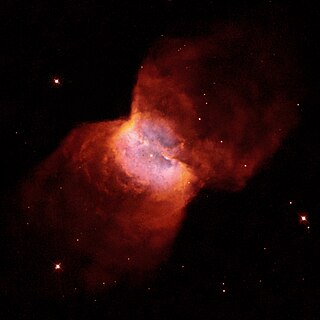
NGC 2346 is a planetary nebula near the celestial equator in the constellation of Monoceros, less than a degree to the ESE of Delta Monocerotis. It is informally known as the Butterfly Nebula. The nebula is bright and conspicuous with a visual magnitude of 9.6, and has been extensively studied. Among its most remarkable characteristics is its unusually cool central star, which is a spectroscopic binary, and its unusual shape.
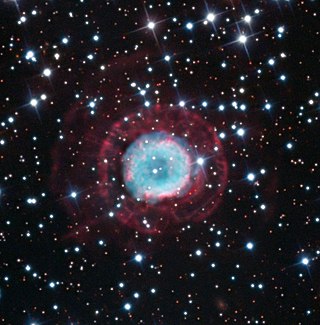
NGC 2438 is a planetary nebula in the southern constellation of Puppis. Parallax measurements by Gaia put the central star at a distance of roughly 1,370 light years. It was discovered by William Herschel on March 19, 1786. NGC 2438 appears to lie within the cluster M46, but it is most likely unrelated since it does not share the cluster's radial velocity. The case is yet another example of a superposed pair, joining the famed case of NGC 2818.

NGC 1514 is a planetary nebula in the zodiac constellation of Taurus, positioned to the north of the star Psi Tauri along the constellation border with Perseus. Distance to the nebula is 466 pc, according to GAIA DR2 data.

NGC 5882 is a small planetary nebula in the southern constellation of Lupus, positioned about 1.5° to the southwest of the star Epsilon Lupi. It was discovered by English astronomer John Herschel on July 2, 1834 from the Cape of Good Hope observatory. John L. E. Dreyer described it as "very small, round, quite sharp". It is located at a distance of approximately 7.7 kilolight-years from the Sun.
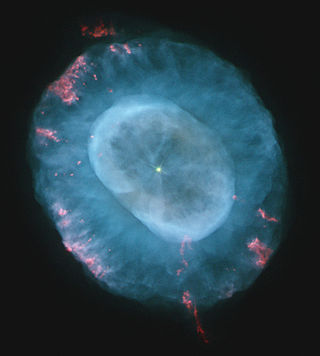
NGC 7662 is a planetary nebula located in the northern constellation Andromeda. It is known as the Blue Snowball Nebula, Snowball Nebula, and Caldwell 22. This nebula was discovered October 6, 1784 by the German-born English astronomer William Herschel. In the New General Catalogue it is described as a "magnificent planetary or annular nebula, very bright, pretty small in angular size, round, blue, variable nucleus". The object has an apparent visual magnitude of 8.3 and spans an angular size of 32″ × 28″. Parallax measurements give a distance estimate of 5,730 ± 340 ly (1,757 ± 103 pc).
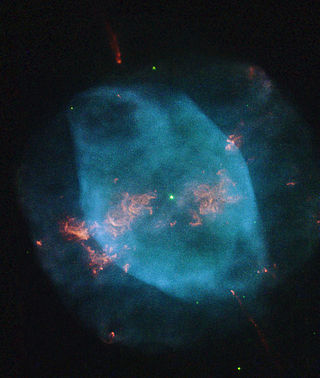
NGC 7354 is a planetary nebula located in the northern circumpolar constellation of Cepheus, at a distance of approximately 5.5 kly from the Sun. It was discovered by German-born astronomer William Herschel on November 3, 1787. John L. E. Dreyer described it as, "a planetary nebula, bright, small, round, pretty gradually a very little brighter middle".

NGC 3195 is a planetary nebula located in the southern constellation of Chamaeleon. Discovered by Sir John Herschel in 1835, this 11.6 apparent magnitude planetary nebula is slightly oval in shape, with dimensions of 40×35 arc seconds, and can be seen visually in telescopic apertures of 10.5 centimetres (4.1 in) at low magnifications.

NGC 5315 is a planetary nebula in the southern constellation Circinus. Of apparent magnitude 9.8 around a central star of magnitude 14.2, it is located 5.2 degrees west-southwest of Alpha Circini. It is only visible as a disc at magnifications over 200-fold. The nebula was discovered by astronomer Ralph Copeland in 1883. The central star has a stellar class of WC4 and is hydrogen deficient with an effective temperature of 76-79 kK. The distance to this nebula is not known accurately, but is estimated to be around 6.5 kilolight-years.

NGC 6884 is a planetary nebula located in the constellation Cygnus, less than a degree to the southwest of the star Ο1 Cygni. It lies at a distance of approximately 12.5 kly from the Sun. The nebula was discovered on May 8, 1883, by American astronomer Edward C. Pickering.

WR 136 is a Wolf–Rayet star located in the constellation Cygnus. It is in the center of the Crescent Nebula. Its age is estimated to be around 4.7 million years and it is nearing the end of its life. Within a few hundred thousand years, it is expected to explode as a supernova.

S Monocerotis, also known as 15 Monocerotis, is a massive multiple and variable star system located in the constellation Monoceros. It is the brightest star in the Christmas Tree open cluster in the area catalogued as NGC 2264.
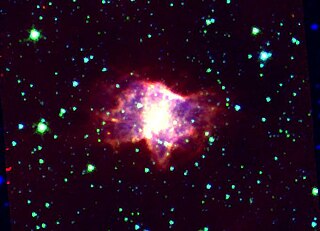
NGC 6072 is a planetary nebulae in the southern constellation of Scorpius. It has a dynamical age of 104 years. Its circumstellar envelope is likely to be rich in carbon as it has very strong CN (cyanide) spectral lines. CN spectral lines are generally not detected in oxygen rich AGB (asymptotic giant branch) circumstellar envelopes. NGC 6072 also shows H2 (hydrogen) emission and intense CO (carbon monoxide) emission which has been mapped displaying bipolarity and some gas at high velocity. The evolution of this planetary nebulae is likely to be dominated by photodissociation and ion/radical molecular reactions. Shock chemistry is also likely to be important.

IC 2448 is an elliptical planetary nebula in the constellation of Carina. It was discovered in 1898 by Williamina Fleming. It lies near the bright star Beta Carinae, and the southern Carina can be explored in the months of autumn in the southern hemisphere. The central star of the planetary nebula is an O-type star with a spectral type of O(H)3 III-V. An analysis of Gaia data suggests that it is a binary system.

Little Ghost Nebula, also known as NGC 6369, is a planetary nebula in the constellation Ophiuchus. It was discovered by William Herschel.

HD 110432 is a Be star in the south-east of Crux, behind the center of the southern hemisphere's dark Coalsack Nebula. It has a stellar classification of B1IVe, which means it is a subgiant star of class B that displays emission lines in its spectrum. This is a variable star of the Gamma Cassiopeiae type, indicating it is a shell star with a circumstellar disk of gas about the equator, and has the variable star designation BZ Crucis. It is not known to be a member of a binary system, although it is probably a member of the open cluster NGC 4609. This star is moderately luminous in the X-ray band, with a variable energy emission of 1032–33 erg s−1 in the range 0.2−12 keV. The X-ray emission may be caused by magnetic activity, or possibly by accretion onto a white dwarf companion.
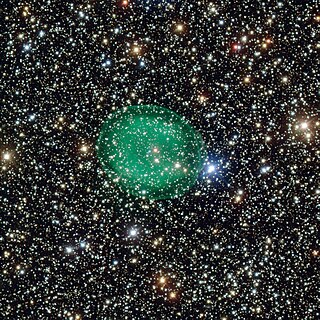
IC 1295 is a planetary nebula in the constellation Scutum. It was discovered in 1867 by Truman Safford. It lies roughly 4,700 light-years away.
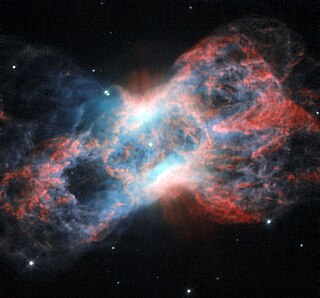
NGC 7026 is a planetary nebula located 6000 light-years away, in the constellation of Cygnus. The central star of the planetary nebula has a spectral type of [WO3], indicating a spectrum similar to that of an oxygen-rich Wolf–Rayet star. An analysis of Gaia data suggests that it is a binary system.

NGC 1501 is a complex planetary nebula located in the constellation of Camelopardalis, it was discovered on the 27th August 1787 by William Herschel. It is also known as the Oyster Nebula.

NGC 6905, also known as the Blue Flash Nebula, is a planetary nebula in the constellation Delphinus. It was discovered by William Herschel in 1784. The central star is 14.0 mag. The distance of the nebula, as with most planetary nebulae, is not well determined and estimates range between 1.7 and 2.6 kpc.
LoTr 5 is a large, faint planetary nebula in the constellation of Coma Berenices. In 2018, its parallax was measured by Gaia, giving a distance of about 1,650 light-years.



















